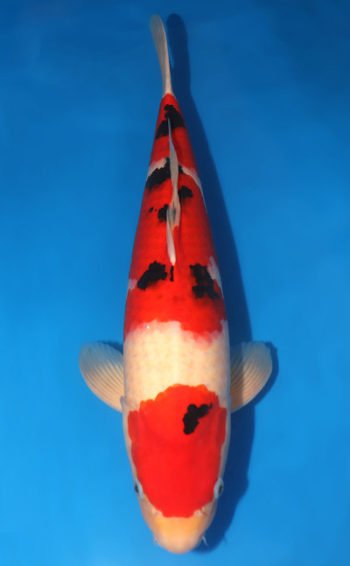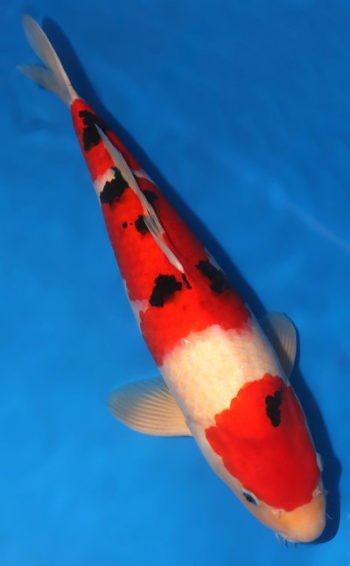Taisho Sanke Koi
See all of our high-quality koi fish for sale & butterfly koi fish for sale. We offer the very best selection of koi for sale in the industry. Put that alongside of our incredible 14-Day Live Arrival Guarantee, and the ability to choose your own delivery date and you have an unbeatable value.
14-DAY WORRY-FREE GUARANTEE: We offer an industry-leading 14-Day Worry-Free Guarantee to ensure that you can shop with peace of mind, knowing that you will always be covered.
Breeder(s): Arowana Paradise Farm
Sex: Male
Size: 19.49 inch
Variety: Taisho Sanke
$160.00 Original price was: $160.00.$150.00Current price is: $150.00.
Description
Taisho Sanke Koi Fish For Sale
Taisho Sanke Koi, the Koi fish hobby can be as addictive as a video game for a teenager. They are a fish of beauty and diverse colors. These spectacular fish can show their personality at meal time. Koi are often overly excited when you feed them and sometimes will display jumping and be trained to eat from your hand. They are omnivorous fish, eating both plants and animals (mostly small crustaceans.) Similar to most nutrition plans, Koi will do best with a properly balanced diet.
When properly cared for in an ideal environment, the Koi will possibly outlive their owners. An average Koi lives 23-30 years, but the oldest known Koi fish lived for 226 years. They range in sizes of 2-3 feet and can weigh up to 35-40 lbs. They are a hardy, cold water fish and will flourish in a temperature range of 59-77 degrees F (15-25 degrees C).
Selecting Taisho Sanke Koi
When selecting a Koi fish to raise and possibly show, it is best to consider many factors such as the color, pattern, body, and overall health. Look for a healthy fish without any body deformities or missing fins. The color should be even and pure with a balanced pattern. When judging the body of a Koi, the head should be symmetrical and in proportion to the body.
An easy way to gauge correct proportion is by looking for a smooth transition of the gill plate that divides the head and body. The best Koi shape is larger at the middle with a gradual tapering towards the head and even more so at the tail. Take into consideration the size of the snout and fins.
For the Sanke variety, the white (shiro) body should be a thick, milky white and not have any yellow tinting or blemishes. The red (hi) markings should be solid and evenly colored and the edges (kiwa) should be defined. The hue can range from a bright orange to a deep red tint. The black (sumi) markings should be solid with clearly defined edges as well. The spotting of dark blue or gray can change into black on a young Koi as it matures. Try to avoid Sanke with any black on the head.
Sanke Variety Koi
A (red) hi pattern that moves from the head to tail continuously is known as an Aka Sanke and are less desired. A Tancho Sanke has a red round patch on the head, with no other red on the body. This Sanke variation is highly sought after in Japan because of the similarity in appearance to the Japanese national bird. If there are red markings on the body as well, then it is known as a Maruten Sanke.
The best way to determine what the high quality Koi looks like is to become familiar by looking at photos of Koi, by joining a Koi club and attending Koi shows. With time, research, and experience, any hobbyist will be able to select the best Koi for their pond and enjoy them for many years.
Koi Care Guide – Six things to know about your koi
- Experience Level: Intermediate
- Size: Koi grow up to 36 inches (91 cm) long
- Lifespan: They can live for more than 50 years and thrive in a wide range of water temperatures
- Temperament: They are generally peaceful but may pick on slower fish
- Origin: They’re a type of carp native to Japan
- Did You Know: Koi can learn to recognize and take food from their pet parents
How do I set up my koi’s aquarium?
- Koi grow quickly and get very large. Keep mature koi in an outdoor pond of at least 3 feet deep, with at least 50 gallons of water per fish.
- Young koi can be kept indoors in an aquarium of at least 29 gallons.
- Put the aquarium in a quiet area out of direct sunlight and drafts.
- Cover the aquarium with a hood to reduce evaporation and splashing and to keep fish from leaping out.
- To transfer new koi to the aquarium, float them in the water inside their bag for about 10 minutes so they can acclimate to the new water temperature.
- If you’re introducing koi to an existing school in an aquarium or pond, quarantine the new fish in a separate body of water for 2 to 4 weeks to be sure they are healthy.
- On moving day, use a net to transfer the koi so old water doesn’t mingle with new water.
- Whether they live indoors or outdoors, add no more than 3 new koi at a time.
Heat & light
Outdoor koi are hardy and will hibernate under ice in winter as long as their pond is deep enough to not freeze completely. (They won’t survive in solid ice.)
Your koi’s pond should be partially shaded.
Indoor koi prefer water between 65 and 75 degrees Fahrenheit.
Install a light inside an indoor aquarium to illuminate it for 8 to 12 hours a day.
Water temperature
Koi are pretty temperature-resistant— they can even hibernate under ice in winter. Just be sure your pond is at least three feet deep— otherwise, it could freeze solid, and koi aren’t that tough. When they live indoors, koi prefer cool water—between 65 and 75 degrees F (18 to 24 C).
How do I keep my koi healthy?
If your outdoor koi don’t seem to be eating in the winter, don’t worry; it’s normal for them to stop eating at temperatures below 40 F. Be sure to contact a veterinarian if you notice any of these symptoms:
- Unusual swimming pattern
- Thinness or decreased appetite
- Abdominal swelling
- Inflamed or discolored skin or fins
- Fins clamped to sides of body
- Scraping body on rocks (flashing)
types of koi fish, koi fish, koi fish price, koi fish pond, koi fish meaning, koi fish for sale, koi fish drawing, koi fish care, koi fish for sale online, butterfly koi for sale, koi fish for sale near me, big koi for sale, buy koi fish cheap, koi fry for sale usa, types of koi fish, koi fish for sale, High Quality Koi, Coy fish, coe fish, showa koi, kohaku koi, tancho sanke, showa fish





Reviews
There are no reviews yet.